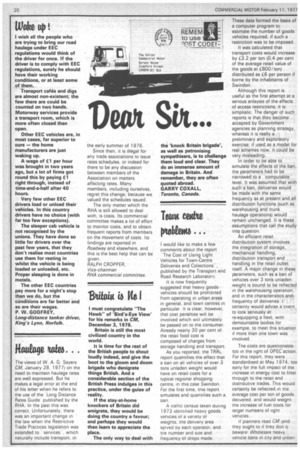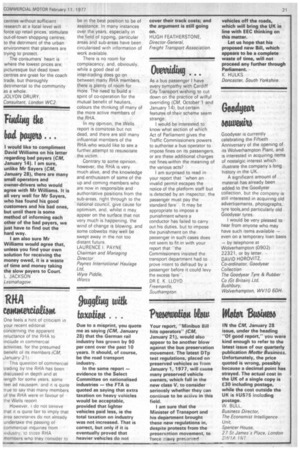would like to make a few comments about the report
Page 22

Page 23

If you've noticed an error in this article please click here to report it so we can fix it.
The Cost of Using Light Vehicles for Town-Centre Deliveries and Coltections-, published by the Transport and Road Research Laboratory,
it is now frequently suggested that heavy goods• vehicles should be prohibited from operating in urban areas in general, and town centres in particular. it is clear, however, that cost penalties will Pe involved which will ultimately be passed on to tne consumer. Already nearly 30 per cent of the retail food cost is composed of charges from storage handling and transport.
As you reported, tne TRRL report quantifies the effect that a ban on all vehicles of over 3 tons unladen weight would nave on retail costs for a typical regionat shopping centre, in thls case Swindon. For the first time, this report simulates and quantifies such a pan.
A trafric census taken during 1973 identified neavy goods vehicles ot a variety of weignts, tne delivery area served ny eacn operator, and tne number and size and frequency of drops made. These data formed the basis of a computer program to estimate the number of goods vehicles required, if such a restriction was to beimposed.
It was calculated that transport costs would increase by £3.2 per ton (0.4 per cent of the average retail value of the goods at £.800/ton) distributed as £6 per person if .borne by the inhabitants of Swindon.
Although this report is useful as the first attempt at a serious anlaysis of the effects of access restrictions, it is simplistic. The danger of such reports is that they become accepted by Government agencies as planning strategy, whereas it is really a preliminary and exploratory exercise; if used as a model for real schemes now, it could be very misleading.
In order to be able to simulate the effects of the ban, the parameters had to be narrowed to a 'computable' level. It was assumed that with such a ban, deliveries would be made with the same frequency as at present and all distribution functions (such as warehousing and trunk haulage operations would remain unchanged. it is these assumptions tnat call the study into question.
An efficient retail distribution system involves the integration of storage, mechanical handling, distribution transport and handling in the retail outlet itself. A major change in these parameters, such as a ban of vehicles over 3 tons unladen vveigni is bound to be reflected in the warehousing operation, and in the characteristics and frequency of deliveries. I certainly would advise a clieht to look seriously at re-equipping a fleet, wan demountabie bodies for example, to meet this situation if more tnan one town was involved.
The costs are questionable too m tee light of OPEC-action. For tnis report, tney were standardised at May 1974, too early for me fult impact of the increase in energy cost to fiiter tnrough to the retail and distributive trades. This would certainly be reflected in tne average cost per ton of goods delivered, and would weight tne increase of fuel costs for larger numbers of light vehicles.
it planners read CM and tney ought to if they don 'q beware' Wholesale neavy venicie bans in city and urban centres without sufficient research at a local level will force up retail prices, stimulate out-of-town shopping centres, to the detriment of the urban environment that planners are trying to protect.
The consumers heart is where the lowest prices are; picturesque but dead town centres are great for the coach trade, but thoroughly detrimental to the community as a whole.
JOLYON DRURY, Consultant, London WC2.
























































































































